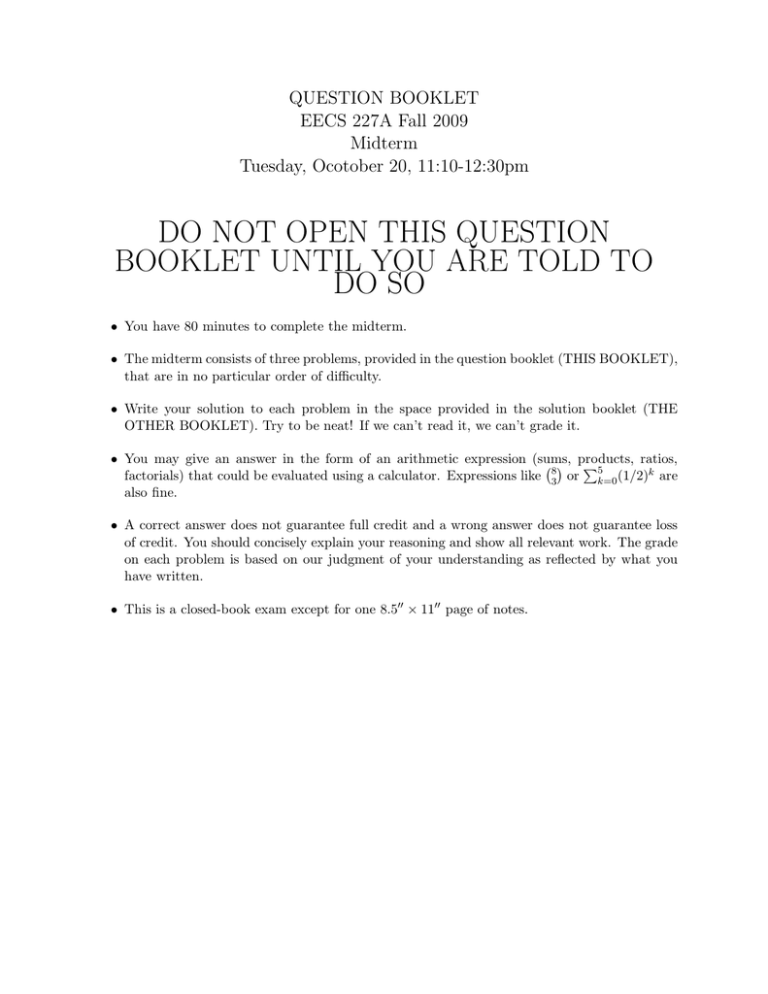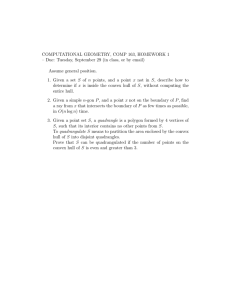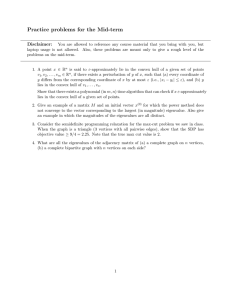Midterm solutions - EECS at UC Berkeley
advertisement

QUESTION BOOKLET
EECS 227A Fall 2009
Midterm
Tuesday, Ocotober 20, 11:10-12:30pm
DO NOT OPEN THIS QUESTION
BOOKLET UNTIL YOU ARE TOLD TO
DO SO
• You have 80 minutes to complete the midterm.
• The midterm consists of three problems, provided in the question booklet (THIS BOOKLET),
that are in no particular order of difficulty.
• Write your solution to each problem in the space provided in the solution booklet (THE
OTHER BOOKLET). Try to be neat! If we can’t read it, we can’t grade it.
• You may give an answer in the form of an arithmetic expression (sums,
ratios,
products,
P
factorials) that could be evaluated using a calculator. Expressions like 83 or 5k=0 (1/2)k are
also fine.
• A correct answer does not guarantee full credit and a wrong answer does not guarantee loss
of credit. You should concisely explain your reasoning and show all relevant work. The grade
on each problem is based on our judgment of your understanding as reflected by what you
have written.
• This is a closed-book exam except for one 8.5′′ × 11′′ page of notes.
Problem 1:
For all parts of this problem, let f be a convex and twice continuously differentiable function.
Consider the steepest descent method
xk+1 = xk − αk ∇f (xk ).
(a) Suppose that ∇2 f (x) ≻ 0 for all x ∈ Rn . How many local minima does f have? How many
global minima does f have?
(b) State a convergence result for the steepest descent method. Be sure to specify explicitly how
your step size is chosen.
(c) Consider the condition
∃ γ > 0 such that
k∇f (x) − ∇f (y)k22
≤ (∇f (x) − ∇f (y))T (x − y) for all x, y ∈ Rn . (1)
γ
Given a quadratic function f (x) = 21 xT Qx − bT x where Q is symmetric, state the weakest
sufficient conditions on (Q, b) under which condition (1) guaranteed to hold.
(d) Assume that there exists some x∗ ∈ Rn such that ∇f (x∗ ) = 0. Assuming that condition (1)
holds, prove that xk → x∗ as long as there is some ǫ ∈ (0, 2) such that the step sizes αk satisfy
ǫ ≤ αk ≤
2−ǫ
γ
for all k = 1, 2, . . ..
Solution:
(a) Under the given condition, any local minimum must be a global minimum. It is possible
that f does not have a global minimum (e.g., f (x) = exp(−x) for x ∈ R.) If it has a global
minimum, then it must be unique since the assumption implies that f is strictly convex on
Rn .
(b) Suppose that f achieves its global minimum at x∗ ; from part (a), x∗ is the only possible
stationary point. Therefore, if we implement steepest descent with αk chosen by the Armijo
rule (as stated in class or in the Bertsekas book), then the sequence {xk } will converge to the
global minimum x∗ .
(c) The weakest sufficient conditions are that 0 Q γI. No conditions on b are needed. We
have ∇f (x) = Qx − b for all x ∈ Rn , and therefore we want to show that there exists γ > 0
such that
kQ(x − y)k22
≤ (x − y)T Q(x − y)
γ
for all x, y ∈ Rn . This will hold if and only if γQ − Q2 0. Let z ∈ Rn be a unit norm
eigenvector of Q associated with a non-zero eigenvalue λ. We then need
γz T Qz − z T Q2 z = γλ − λ2 = λ (γ − λ) ≥ 0.
This inequality holds if and only if λ ∈ [0, γ] for all eigenvalues λ, as claimed.
2
(d) We claim that condition (1) implies that the gradient is Lipschitz with parameter γ > 0.
Indeed, we have
k∇f (x) − ∇f (y)k22
≤ (∇f (x) − ∇f (y))T (x − y)
γ
≤ k∇f (x) − ∇f (y)k2 kx − yk2 ,
using the Cauchy-Schwartz inequality. Therefore, we have k∇f (x) − ∇f (y)k2 ≤ γkx − yk2 for
all x, y ∈ Rn . The claimed convergence result thus follows from a proposition stated in class
(see Prop 1.2.3 Bertsekas).
3
Problem 2:
(a) For some fixed integer n ≥ 1, consider the set
A = (c0 , c1 , . . . , c2n ) ∈ R
2n+1
|
2n
X
ci ti ≥ 0
for all t ∈ [0, 1] .
(2)
i=0
Show that A is a convex cone.
(b) Is A a pointed cone? Prove or disprove.
(c) Given a cone K, define the notion of its dual K ∗ . Show that
(i) K ∗ is convex (even if K is not convex).
(ii) If K has a non-empty interior, then K ∗ is pointed.
(d) Compute the dual cone A∗ to the cone A from part (a).
Hint: you can use the following facts:
(i) given a set S ⊆ Rd , every point in the conic hull of S can be written as a conic combination of some d
points from S.
(ii) for any cone K, we have K ∗∗ = cl(convhull(K)), where cl means taking closure of a set, and convhull
means taking the convex hull.
Solution:
P
i
(a) It is clear that A is a cone, since if 2n
i=0 ci t ≥ 0 for all t ∈ [0, 1], then certainly the same
inequalities hold for λ c, for any λ ≥ 0. To establish convexity, if c and d both belong to A,
then we have
2n
X
i
λci + (1 − λ)di t = λ
2n
X
i
ci t + (1 − λ)
i=0
i=0
2n
X
di ti ≥ 0.
i=0
(b) We claim that A is pointed. To prove this, we need to show that if c ∈ A and −c ∈ A, then
c = 0. Note that both c and −c must satisfy the inequalities
2n
X
i=0
i
ci t ≥ 0, and
2n
X
(−ci )ti ≥ 0, for all t ∈ [0, 1].
i=0
P2n
i
This implies that the polynomial f (t) =
i=0 ci t is identically zero on [0, 1]. Therefore,
we must have f (0) = c0 = 0. Moreover, we must have f ′ (0) = c1 = 0. Continuing with
this procedure (taking derivatives and evaluating at zero), we conclude that ci = 0 for all
i = 0, 1, . . . , 2n, so that c = 0 as claimed.
(c) The dual cone K ∗ = y ∈ Rn | y T x ≥ 0 for all x ∈ K .
(i) Suppose that y, z ∈ K ∗ . Then for any x ∈ K, we have
(λy + (1 − λ)z)T x = λy T x + (1 − λ)z T x ≥ 0,
so that λy + (1 − λ)z ∈ K ∗ as well. Therefore, K ∗ is always convex.
4
(ii) Suppose that z and −z are both elements of K ∗ ; we want to show that z = 0. For any
element x of K, we must have
zT x ≥ 0
(−z)T x ≥ 0,
and
so that z T x = 0 for all elements of K. But if K has a non-empty interior, then we can
find a point x ∈ K and a δ > 0 such that the ball Bδ (x) = {y ∈ Rn | ky − xk2 ≤ δ} is
z
belongs to this ball, whence we
contained with K. If z 6= 0, then the vector x + δ kzk
2
must have
z = z T x + δkzk2 = 0.
zT x + δ
kzk2
Since z T x = 0, this implies that δkzk2 = 0, which is a contradiction.
(d) We claim that A∗ is equivalent to the set
B = conic hull (1, t, t2 , . . . , t2n ) | t ∈ [0, 1] .
To prove
first prove that A = B ∗ . Indeed, any z ∈ B can be written as
Pm this claim, we
2n
z = i=1 λi (1, ti , . . . , ti ) for some λi ≥ 0 and ti ∈ [0, 1]. Consequently, given any c ∈ A, we
have
2n
m
2n
X
X
X
ck tki ) ≥ 0
λi (
ck zk =
cT z =
i=1
k=0
B ∗,
k=0
B∗
which implies c ∈
and hence shows that A ⊆
For the
inclusion, suppose that
P2nreverse
k
c ∈
/ A. Then there must exist some t ∈ [0, 1] such that k=0 ck t < 0. Now if we choose
z = (1, t, . . . , t2n ) ∈ B, we are guaranteed cT z < 0, which implies that c ∈
/ B ∗ . We have thus
shown that Ac ⊆ (B ∗ )c . Since A ⊆ B ∗ and Ac ⊆ (B ∗ )c , we must have A = B ∗ , therefore
A∗ = B ∗∗ .
The second step is to prove that B is a closed set.
Let z be a point in the boundary of B, that is there exists a sequence z k → z as k → ∞
and z k ∈ B, ∀k. Since S = {(1, t, . . . , t2n )|t ∈ [0, 1]} ⊂ R2n+1 , every point in the conic hull of
S canPbe written as a conic combination of some 2n + 1 points from S. We thus can write
2n
z k = 2n
i=0 λk,i (1, tk,i , . . . , tk,i ) where λk,i ≥ 0 and tk,i ∈ [0, 1].
Since tk = (tk,0 , . . . , tk,2n ) ∈ [0, 1]2n+1 - compact set, we can chose a sub sequence K ⊆
{1, 2, . . .} such that tk converges to a point t̄ ∈ [0, 1]2n+1 as k → ∞, k ∈ K.
P2n
Furthermore,
i=1 λk,i → z1 as k → ∞, k ∈ K and λk,i ≥ 0, there exists L such that
λk,i ≤ L, ∀k, i. So λk = (λk,0 , . . . , λk,2n ) ∈ [0, L]2n+1 - compact set thus we can choose a
subsequence K ′ ⊆ K such that λk → λ̄ ∈ [0, L]2n+1 as k → ∞, k ∈ K ′
P
2n
Since z k → z as k → ∞, k ∈ K ′ , we must have z = 2n
i=0 λ̄i (1, t̄i , . . . , t̄i ) ∈ B.
Finally, using the hint, B ∗∗ is the closure of the convex hull of B (see also B V, §2.6.1). In
our case, B is closed and convex, so that we are guaranteed that A∗ = B ∗∗ = B, as claimed.
5
Problem 3:
True or false? Justify your answer. (No points for simply writing down T or F; answers must
be justified with an explicit argument.)
(a) Given a closed convex set C ⊆ Rn , the projection of any pointP
z ∈ Rn under the ℓ1 -norm
onto C exists and is unique. (Recall that the ℓ1 -norm is kxk1 = ni=1 |xi |.)
(b) The set
C = (x, t) ∈ Rn × R |
kxk22
≤t
2
1 + kxk2
is convex.
(c) Let K1 ⊆ Rn and K2 ⊆ Rn be two convex cones with non-empty interiors. If the interiors
of the cones are disjoint, then there exists a non-zero vector y ∈ Rn such that y ∈ K1∗ and
−y ∈ K2∗ .
(d) Given a symmetric matrix A 0, vector b ∈ Rn and scalar c ∈ R, the set
C = x ∈ Rn | xT Ax + bT x + c ≤ 0 .
is convex.
Solution:
(a) False: uniqueness need not hold because the ℓ1 -norm is not strictly convex. Consider the
problem
min |x1 | + |x2 | such that x1 + x2 = 2.
x∈R2
This corresponds to projecting (0, 0) onto the given line. This linear program has infinitely
many optima: e.g., x∗ = (1, 1) and y ∗ = (2, 0) are both optimal solutions.
(b) False. Consider n = 1. Both of the points (0, 0) and (2, 4/5) belong to the set. The average
of these two points is (1, 2/5). However 1/(1 + 1) = 1/2 > 2/5 so it fails to belong to the set.
(c) True. Since int(K1 ) and int(K2 ) are convex and disjoint, they can be separated by a separating
hyperplane of the form {y T x = α} for some y 6= 0. (Explicitly, we have y T x ≥ α, ∀x ∈
int(K1 ) and y T x ≤ α, ∀x ∈ int(K2 ).) By taking limits for boundary points, we also have
y T x ≥ α, ∀x ∈ K1 and y T x ≤ α, ∀x ∈ K2 . We must have α = 0 because K1 and K2 are cones
(so if x ∈ K1 then tx ∈ K1 for all t > 0). This means that y ∈ K1∗ and −y ∈ K2∗ , as claimed.
(d) True. If A 0, then the function f (x) = xT Ax + bT x + c is convex. The given set is the
sub-level set {x ∈ Rn | f (x) ≤ 0} and so must be convex (since f is a convex function).
6

